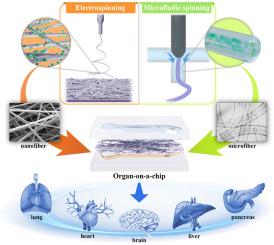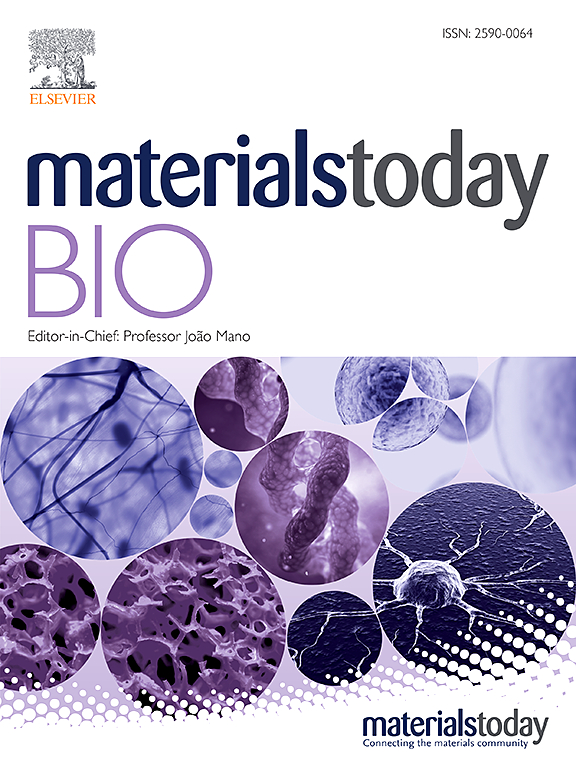用于芯片器官的微型和纳米纤维:构造、应用和前景
IF 8.7
1区 医学
Q1 ENGINEERING, BIOMEDICAL
引用次数: 0
摘要
片上器官是一种体外仿生微系统,可对细胞微环境进行精确调控和实时观察,有望成为再现体外器官真实微环境的强大平台。微环境因素,如活细胞、三维(3D)培养、组织-组织界面和生物力学因素,是构建仿生微系统的重要线索。为活细胞生长提供适当的三维培养环境非常重要。纤维,尤其是微纤维和纳米纤维,可通过表面粘附或内部负载为活细胞提供合适的三维培养环境。此外,纤维还可以通过各种方式在更高层次上进行组装,以创建具有更复杂结构的功能性三维组织或器官,从而进一步扩大其在组织工程和生物医学研究中的应用。利用纤维构建片上器官,无论是作为细胞培养的三维支架,还是更接近地模拟真实组织/器官,都将为开发新型片上器官系统带来新的思路和策略。基于这一背景,本综述总结了用于芯片上器官系统的微/纳米纤维的构建和应用方面的研究进展。综述概述了微/纳米纤维的制备方法和材料选择,并详细介绍了它们在细胞三维培养和芯片上器官构建中的各自策略。本综述还重点介绍了微/纳米纤维在该领域的主要研究成果和应用,这些成果和应用对未来的实践具有重要意义,最后探讨了未来发展的潜在方向。本文章由计算机程序翻译,如有差异,请以英文原文为准。

Micro- and nano-fibers for organ-on-a-chip: Construction, applications, and prospects
Organ-on-a-chip, an in vitro biomimetic microsystem that enables precise regulation and real-time observation of the cell microenvironment, has the potential to become a powerful platform for recapitulating the real microenvironment of organs in vitro. Microenvironmental factors, such as living cells, three-dimensional (3D) culture, tissue–tissue interfaces, and biomechanical factors, are important cues in the construction of biomimetic microsystems. It is important to provide an appropriate 3D culture environment for living cells to grow. Fibers, particularly microfibers and nanofibers, can provide a suitable 3D culture environment for living cells via surface adhesion or internal loading. In addition, fibers can further expand their applications in tissue engineering and biomedical research by being assembled at a higher level in various ways to create functional 3D tissues or organs with more complex structures. The use of fiber to construct an organ-on-a-chip, whether as a 3D scaffold for cell culture or to more closely mimic real tissues/organs, will introduce new ideas and strategies for developing novel organ-on-a-chip systems. Based on this context, this review summarizes the research progress in the construction and applications of micro/nanofibers for organ-on-a-chip systems. It outlines the preparation methods and material selections for micro/nanofibers and provides a detailed overview of their respective strategies for cell 3D culture and organ-on-a-chip construction. This review also highlights the main research findings and applications of micro/nanofiber in this field, which have significant implications for future practice, and finally concludes by examining potential directions for future development.
求助全文
通过发布文献求助,成功后即可免费获取论文全文。
去求助
来源期刊

Materials Today Bio
Multiple-
CiteScore
8.30
自引率
4.90%
发文量
303
审稿时长
30 days
期刊介绍:
Materials Today Bio is a multidisciplinary journal that specializes in the intersection between biology and materials science, chemistry, physics, engineering, and medicine. It covers various aspects such as the design and assembly of new structures, their interaction with biological systems, functionalization, bioimaging, therapies, and diagnostics in healthcare. The journal aims to showcase the most significant advancements and discoveries in this field. As part of the Materials Today family, Materials Today Bio provides rigorous peer review, quick decision-making, and high visibility for authors. It is indexed in Scopus, PubMed Central, Emerging Sources, Citation Index (ESCI), and Directory of Open Access Journals (DOAJ).
 求助内容:
求助内容: 应助结果提醒方式:
应助结果提醒方式:


